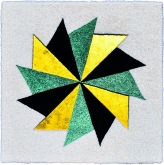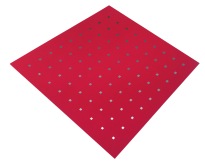Art Karlsruhe Hall 1 Booth B11 und Sculpture stand A17
7–10 July 2022Art Karlsruhe 2022
Art Karlsruhe opens its doors to all art lovers from Thursday throughout the weekend. Galerie Dr. Dorothea van der Koelen is even represented with two stands – B 11 and A 17 – in Hall 1 of the fair. At the main stand B 11, we will be presenting three one-man shows with Lore Bert, Hans Jörg Glattfelder and Nam Tchun-Mo. In addition, other international art greats whom we can count among our gallery artists will be represented at our stand, including Mohammed Kazem, Wulf Kirschner, Fabrizio Plessi, Mario Reis, Vera Röhm, Turi Simeti and Günther Uecker.
But that’s not all: the magnificent ship steel sculptures by the Cuxhaven sculptor Wulf Kirschner, whom we introduced to you in our newsletter a fortnight ago, are extremely expansive and have prompted us to dedicate a separate stand to them. At sculpture stand A 17, diagonally next to our main stand, the artist’s impressive poetic works can be viewed and admired in their full impressive size.
In our video of the week, Dr. Dorothea van der Koelen presents our multifaceted trade fair presence on an entertaining tour, highlighting the various highlights you can discover at our stand.
We look forward to welcoming you in
Hall 1
at Stand B 11 and at our
Sculpture Stand A 17.
You can find our short guide to the works presented
here.
Finally, in this newsletter – following the issue of 23 June 2022 – we would like to introduce you to the stars of our remaining two one-man shows in short portraits: Lore Bert and Hans Jörg Glattfelder.
Born in 1936 in Gießen, Lore Bert has devoted herself entirely to paper. For her filigree works of art, she mainly uses Far Eastern papers from Japan, Nepal, Korea and China, but sometimes also Egyptian papyrus. Lore Bert’s works often have a spatial dimension, be it the pictorial objects whose delicate paper blossoms reach out towards the viewer or the expansive installations that create surging seas of paper. By 2020, more than 125 of these fascinating art spaces had been realised in museums and public exhibition institutes in Europe, Asia, Africa, Arabia, the USA, the Middle East and Mexico.
Lore Bert’s art means ‘nothing’, at least nothing definite in the hermeneutic sense, and does not want to answer any questions. Instead, with quiet caution, she wants to draw attention: to the vulnerability of people and values on the one hand, but at the same time to the beauty and preciousness of people in all their diversity, with all their values, cultures and religions on the other.
Constructive forms, geometry, architectural elements, ornaments, numbers and letters
form her vocabulary of forms, humanities and natural sciences, the world views of
Galileo and Copernicus, philosophical and poetic writings, mathematics and logical
connections, abstract properties, universal relations and the absolute in its poetic
beauty form the intellectual content of her work. Historical contexts or cultural
peculiarities of other countries, which she gets to know through her exhibitions,
find their way into her work, are formulated pictorially and shape the global aspect
of her work.
In a certain sense, Hans Jörg Glattfelder belongs to the circle of the ‘Zurich Concretists’, even though the man born in 1939 is, strictly speaking, a generation younger and – perhaps more importantly – there are no right angles in his work. Rather, he creates visions of right angles and squares for his non-Euclidean metaphors. The square arises only in the imagination of the viewer. Euclid’s conception of geometry, in which distances and angles are assigned specific measures and ratios of parallel or intersecting lines are examined, these postulates are suspended in his work. They are non-Euclidean. The art historian Ulrich Schumacher writes about Glattfelder’s work:
With his structural constellations based on mathematical mind games, he attempts to capture and visualise the movement of time in space with new pictorial means.
But what does metaphor stand for? With the help of metaphors, we try to create images or associations through language by equating one word or circumstance with another by transferring the context of meaning with the aim of clarifying and understanding the meaning.
Perhaps Hans Jörg Glattfelder wants to create an ‘image’ with his non-Euclidean metaphors, i.e. to make the non-visible visible or to make something visible that is not visible. And thus we find ourselves in the realms of Heinz Gappmayr, whose visual poetry achieved something similar with other methods – namely, to depict what cannot be depicted.
Glattfelder’s works are not actually based on mathematics, although he refers to Euclid – one of the most important mathematicians and number theorists. Nevertheless, his works are constructions of the mind that would be inconceivable without mathematics and geometry.
He uses almost the entire palette of colours – initially in the structures on a mostly white or grey ground, then in his later works increasingly in the entire surface, then it can be an intense red, blue or yellow. Green, on the other hand, he uses sparingly, at most in small accents of triangles or squares in the surface structure or in his delicate grid of lines Tucana II from 1982.
Works

Lore Bert
Fan ‧ 2020painting object with Japanese paper and gold leaf
140 x 140 cm
cat. nº 20005

Lore Bert
Chinesische Wörter ‧ 2021folded fields of Japanese paper with ink
140 x 140 cm
cat. nº 21145

Hans Jörg Glattfelder
Phenomenology from Grey to Red ‧ 2016acrylic on canvas on wood
146 x 186 cm
inv. nº 5840

Hans Jörg Glattfelder
Allocation and Division ‧ 1999acrylic on canvas on wood
142 x 180 cm
inv. nº 5850



